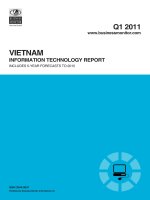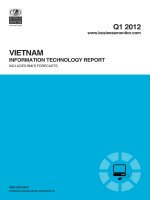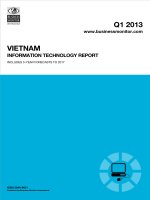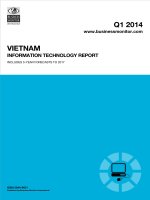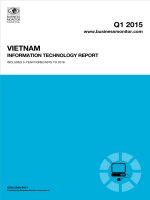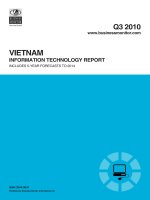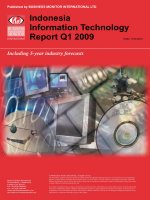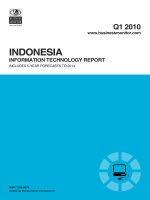Indonesia information technology report q1 2010
Bạn đang xem bản rút gọn của tài liệu. Xem và tải ngay bản đầy đủ của tài liệu tại đây (541.89 KB, 55 trang )
Q1 2010
Published by Business Monitor International Ltd.
www.businessmonitor.com
INFORMATION TECHNOLOGY REPORT
ISSN 1750-5070
Published by Business Monitor International Ltd.
INDONESIA
INCLUDES 5-YEAR FORECASTS TO 2014
Business Monitor International
Mermaid House,
2 Puddle Dock,
London, EC4V 3DS,
UK
Tel: +44 (0) 20 7248 0468
Fax: +44 (0) 20 7248 0467
Email:
Web:
© 2010 Business Monitor International.
All rights reserved.
All information contained in this publication is
copyrighted in the name of Business Monitor
International, and as such no part of this publication
may be reproduced, repackaged, redistributed, resold in
whole or in any part, or used in any form or by any
means graphic, electronic or mechanical, including
photocopying, recording, taping, or by information
storage or retrieval, or by any other means, without the
express written consent of the publisher.
DISCLAIMER
All information contained in this publication has been researched and compiled from sources believed to be accurate and reliable at the time of
publishing. However, in view of the natural scope for human and/or mechanical error, either at source or during production, Business Monitor
International accepts no liability whatsoever for any loss or damage resulting from errors, inaccuracies or omissions affecting any part of the
publication. All information is provided without warranty, and Business Monitor International makes no representation of warranty of any kind as
to the accuracy or completeness of any information hereto contained.
Indonesia Information
Technology Report Q1 2010
Including 5-year industry forecasts by BMI
Part of BMI’s Industry Report & Forecasts Series
Published by: Business Monitor International
Publication date: January 2010
Indonesia Information Technology Report Q1 2010
© Business Monitor International Ltd Page 2
Indonesia Information Technology Report Q1 2010
© Business Monitor International Ltd Page 3
CONTENTS
Executive Summary 5
SWOT Analysis 8
Indonesia IT Sector SWOT 8
Indonesia Telecoms Industry SWOT 9
Indonesia Political SWOT 10
Indonesia Economic SWOT 11
Indonesia Business Environment SWOT 12
Industry Business Environment Overview 13
Table: Regional IT Business Environment Ratings 15
Asia Regional IT Markets Overview 16
IT Penetration 16
Market Growth And Drivers 18
Sectors And Verticals 20
Market Overview 22
Government Authority 22
Table: Key Ministers 22
Background 22
Table: Bandung High-Tech Valley SWOT 23
Hardware 24
Table: Computer Spending By Sector, 2007e 25
Software 25
Services 26
SMEs 28
Industry Developments 28
Open Source Software 28
Industry Forecast 31
Table: Indonesian IT Industry – Historical Data & Forecasts (US$mn Unless Otherwise Stated) 33
Country Context 33
Table: Consumer Expenditure, 2000-2012 (US$) 33
Table: Rural & Urban Breakdown, 2005-2030 34
Internet 35
Internet 35
Table: Telecoms Sector – Internet – Historical Data & Forecasts 35
Competitive Landscape 37
Hardware 37
Software 39
IT Services 39
Internet Competitive Landscape 40
Company Profiles 41
IBM Indonesia 41
Oracle 42
Sigma Cipta Caraka (SCC) 43
Indonesia Information Technology Report Q1 2010
© Business Monitor International Ltd Page 4
HP 45
Country Snapshot: Indonesia Demographic Data 46
Section 1: Population 46
Table: Demographic Indicators, 2005-2030 46
Table: Rural/Urban Breakdown, 2005-2030 47
Section 2: Education And Healthcare 47
Table: Education, 2000-2005 47
Table: Vital Statistics, 2005-2030 47
Section 3: Labour Market And Spending Power 48
Table: Employment Indicators, 2001-2006 48
Table: Consumer Expenditure, 2000-2010 (US$) 48
Table: Average Annual Manufacturing Wages, 2000-2012 (IDR) 49
BMI Methodology 50
How We Generate Our Industry Forecasts 50
IT Industry 50
IT Ratings – Methodology 51
Table: IT Business Environment Indicators 52
Weighting 53
Table: Weighting Of Components 53
Sources 53
Indonesia Information Technology Report Q1 2010
© Business Monitor International Ltd Page 5
Executive Summary
The Indonesian IT market should grow at a compound annual growth rate (CAGR) of around 15% over
2010-2014 despite a deceleration in 2009, when demand was affected by the global economic crisis. In
H109, some manufacturing organisations deferred IT procurements, but there was continued spending in
the financial sector, which had previously accounted for as much as 30% of total spending.
IT spending is expected to increase to US$4.0bn in 2010, up from US$3.5bn last year. Some fundamental
drivers, including low computer penetration and growing affordability, should ensure that the market
remains in positive growth territory. Indeed, Indonesia is projected to be one of the best regional IT
market growth prospects over BMI’s five-year forecast period.
By 2014, Indonesia’s hardware-dominated IT market is projected to reach a value of US$6.9bn, higher
than previously projected. With information and communication technologies (ICT) penetration of only
around 20% and development restricted to richer areas such as Java, the market has much latent growth
potential. However, the country’s uneven development and resultant digital divide are a major barrier to
faster growth within this potentially huge IT market.
Industry Developments
In 2009, a ministerial decree directed that local government offices across Indonesia must adopt open
source software (OSS) by 2011. The mayor of Surabaya revealed in July 2009 that his city had launched a
pilot project for OSS applications. According to the mayor, all Surabaya municipal offices were now
using the software and civil servants had been given relevant training. The local government hoped that
the municipality could save 20-25% of its budget.
E-government is expected to emerge as an area of growing opportunity for IT vendors over the next
couple of years. Currently, several ministries at both federal and province level are planning to implement
projects. In 2008, a number of projects were launched, including an e-procurement system by the State
Ministry for State Enterprise, which covered 25 state-owned enterprises, including oil and gas company
Pertamina and electricity company Perusahaan Listrik Negara.
The government is also rolling out new e-learning initiatives, which could see education’s share of local
IT spending rise from its estimated level of around 4%. The current ratio of PCs to students in public
schools is around 1:3,200 and the government wants to increase this to 1:20. As there are 53mn students
in Indonesia’s schools system, this would require at least 2.5mn computers.
Indonesia Information Technology Report Q1 2010
© Business Monitor International Ltd Page 6
Competitive Landscape
Acer continued in 2009 to expand its presence across both consumer and business segments of the
Indonesia PC market with more product releases. However, HP has pledged to strike back and has set a
target of reclaiming top spot in the Indonesian market from Acer at some point in H110. HP, estimating
the market share gap between itself and Acer at around 10%, has been aggressive in launching new
notebook and netbook series. The company said it was optimistic that it could be leading Indonesia’s PC
market early in 2010 as its products achieved greater penetration.
In 2010, Microsoft hopes that the launch of its Windows 7 operating system, released in October
2009, will boost local sales. Last summer, Microsoft continued to lay the groundwork for the new
operating system launch and released the enterprise version of the software in August. Software market
leader Microsoft Indonesia reported a 30% year-on-year (y-o-y) rise in revenues in FY2008, well above
the company’s global average of 18%.
IT services vendors have reported a growing demand in the telecoms, manufacturing and banking sectors.
Oracle has an agreement with local IT solutions provider PT Sigma Cipta Caraka to provide
outsourcing services. Meanwhile, e-government is also being eyed by IT services vendors as a potential
growth area. Tata Consultancy Services (TCS) said that it had targeted the government as a future
growth driver in the Indonesian market. Currently, TCS’s 15 local clients are principally from sectors
such as banking and financial services, telecoms and media.
Hardware
BMI forecasts 2010 Indonesian computer hardware spending of around US$2.8bn, up from US$2.5bn
last year. Growth decelerated in 2009 but is forecast to return to double digits this year, with the market
rising to a value of nearly US$4.7bn by 2014. Spending in 2009 surpassed initial expectations, due
largely to notebook sales, which surged with the popularity of netbooks; notebook sales grew faster than
desktops in H109.
Hardware accounts for more than 70% of Indonesian IT spending. In 2009, the main driver was
the consumer segment, which accounts for around 25% of computer demand. In H109, consumer demand
was resilient, growing 5.5% in Q109. The main drivers were growing affordability and more credit
availability.
Software
Indonesia’s software sales are projected by BMI at US$475mn in 2010, up from an estimated US$410mn
in 2009. In 2010, sales of Microsoft’s new Windows 7 operating system has the potential to have an
impact, although much will depend on consumer and business confidence. There should also be a boost
from systems upgrades delayed from 2009. One market inhibitor is the continuing software piracy
Indonesia Information Technology Report Q1 2010
© Business Monitor International Ltd Page 7
problem which, by the local government’s own figures, loses Indonesian software companies alone more
than US$100mn a year.
Over the forecast period, enterprise resource planning (ERP) software continues to be of most interest to
the small and medium-sized enterprises (SMEs) market as currently only around 20% of Indonesian
SMEs are estimated to make use of IT.
IT Services
Indonesia’s IT services market is expected to be worth US$683mn in 2010, recording double-digit growth
from US$601mn in 2009, based on BMI estimates. Currently, IT services account for only 17% of
Indonesia’s hardware-centric IT market sales. Hardware deployment services remain the largest
Indonesian IT services category, with approximately a 20% share.
In 2009, the banking sector continued to provide opportunities for IT vendors, despite the fallout from
the global financial crisis. Banks continued with transformation strategies driven by factors such as new
technologies and services as well as regulatory compliance. However, most opportunities are currently
in fundamental service areas such as system integration, support systems, training, professional services,
outsourcing and internet services.
E-Readiness
Low telephone line density, high charges and low PC penetration are all significant obstacles to higher
internet penetration. However, the picture is not all bad as there are signs of faster growth in user numbers
and recent surveys have shown that, among a very small elite, there is fast adoption, by regional
standards, of broadband and a willingness to pay for video conferencing, security and other additional
features. The government is encouraging fixed wireless deployments, including WiMAX, to bring the
internet to more remote areas.
The government is also rolling out an internet-based National Education Network, which involves 1,000
network points in five clusters nationwide, designed to facilitate the use of the internet in schools. Despite
some advances in e-education, constraints remain due to poor infrastructure and lack of public awareness
in a country where only 20mn people own fixed-line telephones.
Indonesia Information Technology Report Q1 2010
© Business Monitor International Ltd Page 8
SWOT Analysis
Indonesia IT Sector SWOT
Strengths
Large potential market
Market may be entering faster growth stage; it is forecast to grow faster than most
ASEAN markets over the review period (up to end-2014) due to its underdeveloped
nature
Weaknesses
Computer penetration among the lowest in South East Asia, estimated at only around
1.5%
Underdeveloped telecommunications infrastructure due to years of government
control and slow progress in deregulation
Lack of government support. Still no unified ICT ministry
History of political instability of late
Legal concerns, such as intellectual property rights, are a deterrent to foreign direct
investment
Opportunities
Some positive trends: computer ownership and internet access are on the rise and the
government is showing signs of taking intellectual property more seriously
Per capita IT spending to increase by 50% over 2010-2014
Opportunities exist in services such as system integration, support systems, training,
professional services, outsourcing and internet services
Computer sales predicted to show faster growth than almost anywhere in the ASEAN
over the next few years, although from a lower base
Threats
Continuing lack of government action to support increased PC penetration and
internet access, and drive ICT sector development
Global economic slowdown may hit key demand segments
Indonesia Information Technology Report Q1 2010
© Business Monitor International Ltd Page 9
Indonesia Telecoms Industry SWOT
Strengths
Fast-growing mobile sector due to the emergence of greater competition
Presence of key strategic investors including SingTel, ST Telemedia of Singapore,
Telekom Malaysia and Maxis of Malaysia, Hong Kong’s Hutchison and the UAE’s
Etisalat
Weaknesses
Security and corruption issues still make Indonesia a risky investment climate
Limited mobile spectrum due to overcrowding in the sector, following government
decision to open the market to greater competition
Mobile broadband spectrum fees remain high for operators, reducing implementation
and variety of tariffs
Operators struggling with raised costs after the government forced companies to
charge a fee based on cost rather than share part of their revenues
Opportunities
Mobile market expected to surge over the coming years, reaching nearly 431mn
people in 2013
Popularity of mobile value-added/data services offers potential to international content
providers
Growth of 3G telephony will lead to investment opportunities for content providers and
distributors
Threats
Government registration scheme could lead to short-term fall in fixed wireless and
mobile users as non-registrants are deactivated
Dominance of prepaid market leading to falling average revenue per user rates
Mobile operators could put too much emphasis on 3G mobile network expansion
when consumer demand is unproven at the expense of 2G growth
Indonesia Information Technology Report Q1 2010
© Business Monitor International Ltd Page 10
Indonesia Political SWOT
Strengths
Indonesia managed a successful transition to democracy in 2004. In addition, the
2009 parliamentary and presidential elections passed by peacefully, signalling the
consolidation of the democratic process.
The military’s role in politics has gradually been reduced. The prospects of a military
coup – which seemed a real possibility in the late 1990s and early 2000s – have
diminished substantially.
Weaknesses
Indonesia’s domestic political scene is characterised by a proliferation of minority
parties, and formal and informal coalitions are necessary to govern and legislate.
Moreover, the efficiency of state institutions is encumbered by bureaucracy and
corruption.
Indonesia’s cultural and ethnic diversity saw the archipelago wracked by separatist
rebellion and ethnic violence in the late 1990s and early 2000s, which took great
efforts to bring to heel. In the event of a new economic crisis, calls for regional
secession could re-emerge.
Opportunities
President Susilo Bambang Yudhoyono’s Democratic Party had a strong showing in
the 2009 parliamentary elections. Coupled with a strong mandate following his re-
election in the same year, the implementation of policies in the legislature should
potentially become less problematic.
Indonesia’s status as the world’s most populous Muslim country leaves it well
positioned to speak out on global Islamic issues, and act as a bridge between the
Middle East and the Asia-Pacific region.
Threats
Regional militant group Jemaah Islamiah (JI) poses a lingering threat to security in
Indonesia. JI is blamed for a series of attacks, including the Bali bombings of October
2002 and other such incidents, including the Jakarta bombings of July 2009.
The fact that Indonesia subsidises basic goods means that when the government
raises prices, there is a risk of public unrest, or at least a political backlash.
Indonesia Information Technology Report Q1 2010
© Business Monitor International Ltd Page 11
Indonesia Economic SWOT
Strengths
Indonesia’s strategic location between the Indian and Pacific Oceans and its
adjacency to major East-West trade routes make it an important economy in the
region.
Indonesia has a low cost and large supply of available labour resources.
Weaknesses
Indonesia’s economy is not growing fast enough to reduce joblessness. Although
unemployment has been decreasing, the unemployment rate is still relatively high, at
8.1% in February 2009. Many are forced to work in the informal sector.
Indonesia’s physical infrastructure is considered substandard. The archipelagic nature
of the country makes it difficult to weave national infrastructure together.
Opportunities
Indonesia could attract much-needed foreign investment by strengthening its business
environment, particularly through reform of its unreliable legal system.
Indonesia stands to benefit from the rise of Islamic financing, having adopted new
legislation in early 2008 designed to tap into this rapidly expanding sphere.
Threats
Production at Indonesia’s ageing oil fields has been in decline since the mid-1990s.
Thus, the country has become a net importer of crude oil in recent years, adding
downward pressure on its current account position.
Indonesia is perceived as one of Asia’s riskier destinations. This leaves the economy
vulnerable to sudden capital outflows at times of risk aversion, which can lead to
sharp swings in the currency.
Indonesia Information Technology Report Q1 2010
© Business Monitor International Ltd Page 12
Indonesia Business Environment SWOT
Strengths
Indonesia is South East Asia’s largest economy with a nominal GDP of US$500bn,
and is the world’s fourth-most populous country with almost 240mn people. It thus
offers investors a vast home market in which to do business.
Indonesia is also a founding member of the Association of South East Asian Nations
(ASEAN). As a member of ASEAN’s Free Trade Area (AFTA), Indonesia is committed
to lowering tariff and non-tariff barriers to trade.
Weaknesses
Corruption remains a major problem. Indonesia ranked 126th out of 180 countries
surveyed in Transparency International’s 2008 Corruption Perceptions Index, where a
low ranking denotes a higher degree of corruption.
Indonesia’s excessive bureaucracy makes it a difficult place to do business. Among
Asian economies, Indonesia has the longest period to start a business. Labour laws
are also considered excessive.
Opportunities
The Yudhoyono administration has gradually been reforming the business
environment, particularly by strengthening the legal system and fighting corruption. If
sustained, this would boost investor interest in Indonesia.
Indonesia has been amending its debt and banking regulations in 2008, with the aim
of attracting Islamic financial activities.
Threats
Recent high-level business disputes between the government and foreign investors
demonstrate that even after investments become up-and-running, there is still scope
for legal problems or obstacles posed by legal wrangling.
Security threats are a concern for investors. Despite several of its top leaders having
been arrested in recent years, Jemaah Islamiah, the radical Islamist militant group
blamed for the Bali bombings, remains active. There is also a low-level threat from
separatist rebels or from intercommunal tensions.
Indonesia Information Technology Report Q1 2010
© Business Monitor International Ltd Page 13
Industry Business Environment Overview
BMI’s Asia IT Business Environment Ratings compare the potential of a selection of the region’s
markets over our forecast period, through to 2014. The ratings reflect our consideration of political and
economic risks, as well as risks associated specifically with IT intellectual property (IP) rights protection
and the implementation of government spending projects.
In 2009 the global economic slowdown had a marked impact across Asian IT markets, with spending
growth declining sharply in states like Malaysia, but holding up relatively well in others like Australia.
Australia’s top ranking is in part due to government ICT programmes, such as the government National
Broadband Network project. The ambitious broadband plans will drive development of Australia’s digital
economy and feed demand for PCs. Government tenders will also generate opportunities in years to come
in areas such as education, e-government, transport and healthcare.
The two smaller, but mature, IT markets of Singapore and Hong Kong take second and third spots in our
rankings table respectively, due primarily to their high country structure scores. Hong Kong continues to
offer investors in the IT field opportunities associated with its growing links to the vast Chinese market.
Singapore benefits from high broadband penetration and initiatives such as the government’s ambitious
‘Intelligent Nation 2015’ plan and the standard operating environment.
On the downside, the continued restructuring of both economies to a more service-oriented economic
model may limit long-term growth prospects, although this also brings opportunities in sectors such as
financial services and banking. Businesses will probably remain cautious and value-focused in the near
term, By the end of 2009, surveys showed significantly better business sentiment.
South Korea, in fourth place in our table, was hit by the global economic downturn, but BMI forecasts
that Korean per capita IT spend will rise from US$750 in 2010 to US$921 in 2014 Consumers seem
willing to upgrade their PCs, and there is also a trend for households to own more than one PC. There will
be a number of key growth areas such as industry-specific software applications, and IT outsourcing,
which is expected to show a strong demand trajectory.
In China, factors such as the vast potential rural market, government spending and demand from key
verticals such as telecoms should drive growth. Key sectors currently include telecoms, government,
energy, social security, education and transport. However, there are still risks associated with IP rights
protection and piracy and a lack of business environment transparency. Pressure on hardware prices is
also a risk in the current environment.
Malaysian IT spending growth will be driven by a rise in the current PC penetration level of around 35%,
rising incomes and a high-tech focused national development plan. The subsidised roll-out of a high-
Indonesia Information Technology Report Q1 2010
© Business Monitor International Ltd Page 14
speed broadband network will address a relative lack of information and communication technology
(ICT) infrastructure outside the Klang Valley. There are also increasingly attractive opportunities in the
IT services area as the government implements measures to make Malaysia a growing regional services
and outsourcing hub.
In the Philippines, the IT market will be driven by further growth in the local IT and business process
outsourcing (BPO) sector. The Philippines has a lower PC penetration than many other Asian countries,
and the IT market offers correspondingly high growth potential over the forecast period. However, there
are challenges such as labour shortages and rising wages.
In 2009, the Indian authorities announced a series of measures to stimulate the domestic IT market as well
as assist domestic IT companies. The potential is plain, with less than 2% of the population owning a
computer, about one-fifth the level in China. Realisation of this long-term growth potential depends on
fundamental drivers such as raising India’s low computer penetration, rising incomes, falling computer
prices and the government’s ambitions to connect the vast rural areas to the outside world.
Three South East Asian markets occupy the final three positions in our table, with low rankings due
primarily to business environment factors, despite considerable growth potential. In Thailand, once an
upturn starts, IT spending could spurt forward again as customers make good on pent-up demand. The
fundamentals of growing affordability and low PC penetration should keep the market in positive territory
during the forecast period. A number of factors should also support momentum, including a Government
PC for Education programme, and 3G mobile and WiMAX broadband service roll-outs.
Similarly, with ICT penetration of only around 20% and development restricted to richer areas such as
Java, the Indonesian IT market has much latent growth potential. BMI expects the Indonesian market to
bounce back strongly from the deceleration last year and become one of the best regional IT market
growth prospects over BMI’s five-year forecast period. The small and medium-sized enterprise (SME)
sector will drive demand for basic hardware and applications as enterprises look to enhance productivity
Sri Lanka’s IT market has felt the effects over the years of the country’s political economic instability,
from disruption of distribution channels and a flourishing grey market to underdeveloped telecoms
infrastructure. However, the market will feature on IT vendors’ radar as among the best potential growth
prospects in South Asia Computerisation has only just got started in the government service, and major
public and private sector organisations remain largely underpenetrated in terms of basic enterprise
software.
Indonesia Information Technology Report Q1 2010
© Business Monitor International Ltd Page 15
Table: Regional IT Business Environment Ratings
Limits Of Potential Returns
Risks To Realisation Of
Returns
IT Market
Country
Structure
Limits
Market
Risks
Country
Risk
Risks
IT BE
Rating
Regional
Ranking
Australia 62 100 75 80 75 77 75.6 1
Singapore 52 95 67 70 90 82 71.4 2
Hong Kong 47 90 62 70 88 81 67.6 3
South Korea 63 70 66 75 68 71 67.2 4
China 69 25 54 35 69 55 54.2 5
Malaysia 50 50 50 35 71 57 52 6
Philippines 48 40 45 43 57 51 46.7 7
India 52 10 37 45 54 50 41.1 8
Thailand 45 15 35 35 62 51 39.5 9
Indonesia 37 30 35 35 36 36 35.1 10
Sri Lanka 33 10 25 35 36 36 28.2 11
Source: BMI. Scores out of 100, with 100 highest. The IT BE Rating is the principal rating. It comprises two sub-
ratings ‘Limits Of Potential Returns’ and ‘Risks To Realisation Of Returns’, which have a 70% and 30% weighting
respectively. In turn, the ‘Limits’ Rating comprises IT Market and Country Structure, which have a 70% and 30%
weighting respectively and are based upon growth/size/maturity/govt. policy of the IT industry (Market) and the
broader economic/socio-demographic environment (Country). The ‘Risks’ rating comprises Market Risks and Country
Risk which have a 40% and 60% weighting respectively and are based on a subjective evaluation of industry
regulatory and IP regulations (Market) and the industry’s broader Country Risk exposure (Country), which is based on
BMI’s proprietary Country Risk Ratings. The ratings structure is aligned across the 14 Industries for which BMI
provides Business Environment Ratings methodology and is designed to enable clients to consider each rating
individually or as a composite, which the choice depending on their exposure to the industry in each particular state.
For a list of the data/indicators used, please consult the appendix at the back of the report.
Indonesia Information Technology Report Q1 2010
© Business Monitor International Ltd Page 16
Asia Regional IT Markets Overview
IT Penetration
Internet Penetration
Broadband Internet Penetration
(per 100 of population)
(per 100 of population)
e/f = estimate/forecast. Source: BMI
e/f = estimate/forecast. Source: BMI
Across Asia, government ICT initiatives and growing affordability will drive increases in PC penetration
during BMI’s forecast period to 2013. While some cities and regions stand out, there is an unbalanced
pattern of regional development, with PC penetration in countries like Singapore being above 50%, while
in other countries, such as Indonesia, it is less than 2%.
The two Asian giants, China and India, embody the region’s growth potential, as in both countries
computer ownership remains the preserve of a minority. In China, PC penetration was only around 16%
in 2007 – although it was far higher in cities like Shanghai and Beijing – and projected to pass 25%
overall by 2013. In India, less than 2% of people own a computer. However, some 45% of the population
is under 25, which provides a promising demographic context for increased PC ownership. The
government’s ultimate target of 1bn internet-connected computers in India is equivalent to the total
estimated number of PCs in the world today.
Around the region, affordable computer programmes are finding favour with governments. In early 2009,
China announced a new subsidised PC programme aimed at rural residents. In the Philippines, where
penetration is currently around 5%, the government launched its PC4All programme in 2007. In
Indonesia, penetration of around 2% could double by 2013 if government initiatives are followed through.
The Indonesian government is also rolling out new e-learning initiatives, with a target of raising the
current 1:3,200 ratio of PCs to students in public schools to 1:20.
A similarly broad range is found with respect to internet penetration. India and Indonesia are now above
17% penetration, despite a lack of fixed-line infrastructure in those countries. Both have deployed fixed-
Indonesia Information Technology Report Q1 2010
© Business Monitor International Ltd Page 17
wireless technologies as one alternative solution, and overall penetration should pass 30% in both by
2012. The fastest growth is projected for India, in which penetration is projected to increase from 17.7%
to 44% by 2013, while Indonesia suffers from high tariffs.
Some 46% of Malaysians had internet access in 2008. Across the region, government programmes are an
important driver of ICT penetration. The Chinese government has a five-year plan to make the internet
available in every administrative village in central and eastern China and every township in the west.
Dial-up technology is still the dominant access method. However, even in developing markets, the
number of broadband subscribers continues to gain ground steadily. In China, broadband penetration is on
course to reach 31% by 2014. In India, where the government designated 2007 as ‘the Year of
Broadband’, penetration should increase tenfold to reach 5.5% by 2013 from around 0.5% currently. This
is far below government targets, however. Malaysia and Singapore will also see strong growth in the
number of broadband subscribers.
Governments around the region are interested in WiMAX as a potential alternative broadband access
method, with India and Malaysia among the countries where network deployments are planned.
Meanwhile, the growth of Wi-Fi coverage will be one driver of notebook sales in places like Hong Kong,
where the government has committed another HKD200mn to the deployment of a Wi-Fi network
covering more than 200 public venues.
Indonesia Information Technology Report Q1 2010
© Business Monitor International Ltd Page 18
Market Growth And Drivers
IT Market Sizes (US$mn) IT Market Sizes As % Of National GDP
(2008e) (2008e and 2013f)
e = estimate. Source: BMI
e/f = estimate/forecast. Source: BMI
Most Asian IT markets are expected to remain in positive growth territory in 2009, despite an expected
impact on IT spending from the global economic slowdown. Across the region, demand from both
business and consumer segments weakened in H208, after robust sales in the first half of the year. The
difficult economic headwinds will persist in 2009, but strong fundamental demand drivers meant that
there will be continued opportunities. Key factors include cheaper PCs and reform in sectors such as
telecommunications and finance, as well as government initiatives.
In China, the falling stock market and high inflation affected consumer sentiment in 2008, while declining
external demand influenced business investment plans. However, BMI expects IT market growth to be
maintained by an expansion into western China, rural areas and lower-tier cities, as well as growing
demand from SMEs. IT spending will also receive a boost from government spending and IT projects
associated with the Shanghai World Expo in 2010.
In India, IT spending growth slowed significantly in 2008 and is expected to ease further in H109, before
starting to recover in H209. Fundamental market drivers include the government’s ambitions to connect
the vast rural areas to the outside world, coupled with falling computer prices. In early 2009, India’s
government announced a series of measures to stimulate the market. Meanwhile, India’s business process
outsourcing industry is growing at around 40% per annum and will continue to generate opportunities for
vendors of IT products and services.
Indonesia Information Technology Report Q1 2010
© Business Monitor International Ltd Page 19
As mentioned above, the Philippines is one of
the countries currently benefiting from low-
priced PC programmes (PC4ALL), which
provide opportunities for vendors to penetrate
the low-income segments. Other regional
computer sale drivers over the forecast period
include education, lower prices, IP telephony,
cheaper processors as well as notebook
entertainment and wireless networking features.
Meanwhile, in Indonesia, relatively low levels
of government IT spending may mean that the
IT market lacks a stabiliser that could help
immunise it from the slowdown. Once again,
however, the basic demographics of low
computer penetration and growing affordability should keep the market in positive territory.
In more developed markets, such as Hong Kong and Singapore, there were indications of declining
consumer and business sentiment in H208, but IT spending remained in positive territory for the year as a
whole. The Singaporean government continued to be a major factor in 2008, with the US$1.3bn Standard
Operating Environment tender award. In Hong Kong, rising unemployment and exposure to the financial
crisis will contribute to slower growth in 2009, but this will be partly counteracted by higher government
IT spending as well as cross-border trade and co-operation.
The largest IT market in the region is, unsurprisingly, China, estimated at US$73.1bn in 2008, trailed
distantly by India (US$13.8bn) and Singapore (US$4.8bn). Singapore’s IT market (including
communications) is the largest as a proportion of national GDP (2.7%), followed by China, Hong Kong
and Malaysia, all at 1.9%.
The fastest growing IT market over the forecast period looks set to be India, with 2008-2013 compound
growth of 79%, taking first place due largely to low PC penetration. China is second, with the IT market
growing by an estimated 74% over the forecast period.
IT Markets Compound Growth
(2008e-2013f, %)
e/f = estimate/forecast. Source: BMI
Indonesia Information Technology Report Q1 2010
© Business Monitor International Ltd Page 20
Sectors And Verticals
Regional IT markets will remain hardware-centric, with hardware accounting for 45-68% of total
spending in all markets. However, spending on software and services will grow faster. Notebook sales are
growing much faster than the PC market as a whole with growth driven by falling prices and more
features.
This year is likely to be a challenging year for hardware sales. In many markets, demand proved quite
robust in H108 and exceeded forecasts, but there were signs of a slowdown towards the end of the year.
Demand from under-penetrated rural areas, affordable computer programmes and growing broadband
penetration should generally prevent stagnation.
In both emerging and more mature markets, the growing popularity of broadband will help to support
computer sales. China Telecom is among regional telecoms companies to have rolled out PC bundling
offers as part of its broadband packages. Meanwhile, a wave of 3G launches across the region should also
provide a stimulus to sales of notebooks, with Vodafone Hong Kong among service providers offering
3G/HSPA USB modems bundled with their 3G services.
In much of emerging Asia, demand from smaller towns and rural areas will provide the main source of
growth, along with replacement of desktops with notebooks. SMEs will be one of the strong growth
segments over the forecast period, with SME demand for servers and networking equipment a significant
growth opportunity.
Market Structure (% Of Total IT Market)
(2008e) (2013f)
e = estimate. Source: BMI f = forecast. Source: BMI
Indonesia Information Technology Report Q1 2010
© Business Monitor International Ltd Page 21
Due in part to high levels of piracy, software’s share of IT spending is relatively low, ranging from 11-
25% among countries covered by BMI. Efforts are being made to tackle the issue of piracy, but despite
government crackdowns in China and the Philippines, software piracy remains above 70% in most of
emerging Asia.
Despite the economic downturn, there are still expected to be opportunities for software vendors in most
markets. The economic situation is likely to lead to further consideration of open source solutions in some
sectors and to encourage vendors to promote software-on-demand solutions. There is a growing trend for
smaller companies to seek greater efficiency by using IT to improve productivity and reduce costs
(including labour costs). In general, ERP and other e-business products still dominate the enterprise
software market, but vendors are also looking to other areas such as customer relationshiop management
(CRM) and business intelligence, where faster growth is possible.
The IT services segment accounts for 17-40% of spending in the Asian markets covered by BMI. The
economic situation and credit tightening are likely to have an impact on projects in some verticals, but
continued demand in sectors like telecoms and banking will help to prevent stagnation. Government
spending will account for a larger share of spending in many markets. In China, government stimulus
packages should drive IT-related investments, while Singapore government ICT tenders were worth an
estimated US$1bn in 2008 and the Hong Kong government’s Digital 21 initiative will continue to
generate a number of projects.
Regionally, hardware deployment services remain the largest IT services category, with other
fundamental services including system integration, support systems, training, professional services,
outsourcing and internet services. Main spenders across the region include banks and financial institutions
as well as governments. Even in emerging markets like India, IT vendors are having to pay more attention
to value-added services such as technical support and product troubleshooting, or basic IT and hardware
consulting.
In many countries, the number and size of local outsourcing deals are increasing. Outsourcing could
account for as much as 30% of China’s IT services spending by 2013, while in India there have been
some large contracts such as that awarded by Idea Telecom to IBM. Singapore – where the government
was to tender a major outsourcing contract in 2008 – and Hong Kong have both seen a trend towards
larger outsourcing projects in the public and private sectors.
Indonesia Information Technology Report Q1 2010
© Business Monitor International Ltd Page 22
Market Overview
Government Authority
In November 2006, Indonesia’s president, Susilo Bambang Yudhoyono, announced the establishment of a
new guiding body to provide strategic direction for the country’s IT development. The National
Information and Communications Technology Council Indonesia is chaired by the president himself and
is tasked with formulating IT policy. The other main task for the committee is to co-ordinate a cross-
departmental e-government initiative at all levels, and the committee also has ministers representing 10
other ministries including finance, law, education, trade and research & technology. The committee has
been tasked with implementing a large and ambitious programme of ICT initiatives including completing
the Palapa Ring Project, which is to cover 50% of cities. There are also responsibilities related to e-
procurement and applying IT to education. The council has a working team with experts drawn from the
business community and IT associations as well as government.
Other relevant government bodies and ministers include:
Table: Key Ministers
Industry Adung Nitimiharja
Small and Medium Enterprises Soegiharto
Research and Technology Kusmayanto Kadiman
Information and Communication Sofyan A Djalil
Key Departments
Badan Koordinasi Penanaman Modal
(BKPM)
State Ministry for Investment/Investment Co-ordinating Board
Badan Pengkajian dan Penerapan
Tehnologi (BPPT)
State Ministry for Research and Technology/Agency for the Assessment
and Application of Technology
Departemen Perindustrian dan
Perdagangan (DEPPERINDAG) Department of Industry and Trade
Departemen Perhubungan Department of Communications
Background
The government has a target of providing telephone and IT services to all rural areas in Indonesia by
2015. The programme is being promoted by the State Ministry for the Development of Disadvantaged
Regions. Under the 1999 Telecoms Law, all telecoms operators and service providers in Indonesia have
an obligation to universal service, but in reality there is a considerable challenge in providing connections
given the geographically dispersed nature of Indonesia’s population and challenging terrain.
Indonesia Information Technology Report Q1 2010
© Business Monitor International Ltd Page 23
The local computer hardware market enjoyed a growth rate of 15-20% per year during the 1990s, with
several foreign computer companies establishing production plants in Indonesia and substantial imports
despite a competitive market for locally assembled personal computers. At the height of the 1990s boom,
the government established Bandung High-Tech Valley (BDHT), located a few hours outside Jakarta. The
valley is an important centre for telecommunications and engineering in addition to being home to several
universities.
Table: Bandung High-Tech Valley SWOT
Strengths
Many top universities, research centres tech-related corporations
More than 500,000 high-tech workers
Some tax incentives
Weaknesses
Inadequate government incentives
Weak telecommunications infrastructure
No international airport
Opportunities
Fast-growing number of small start-up companies
Government talking of new package to attract investors and cut red tape
Threats
Competition from other ‘silicon valleys’ in the region, e.g. Malaysia MSC, and even
from within Indonesia, e.g. Bali Camp
The financial crisis of 1997, which saw a 70% fall in the value of the rupiah against the US dollar,
alongside other far-reaching economic and political consequences, had a large impact on the IT market.
Several multinationals withdrew credit from local distributors and there was some cancellation of planned
investments.
The economy has gradually recovered. However, the development of the local IT market, despite inherent
potential, is restrained by a number of factors including poor telecommunications infrastructure, partly as
a result of slow progress in deregulation and liberalisation. Deregulation has been slow in other sectors of
the economy as well, with the local business environment highly bureaucratic even by regional standards.
Another problem has been the lack of government support for the market and domestic sectors, as shown
by the lack of a dedicated IT ministry. Programmes to widen computer ownership and internet access
have been modest in scale and lacking in effect compared with elsewhere in the region, and it remains to
be seen whether this may change with the new government. Legal issues such as intellectual property
rights have also been a barrier to foreign investment. Furthermore, the software piracy rate remains
among the highest in the world.
Indonesia Information Technology Report Q1 2010
© Business Monitor International Ltd Page 24
Hardware
BMI forecasts 2010 Indonesia computer hardware spending of around US$2.8bn, up from US$2.5bn last
year. Growth decelerated in 2009 but is forecast to return to double digits this year, with the market rising
to a value of nearly US$4.7bn by 2014. Spending in 2009 surpassed initial expectations, due largely to
notebook sales, which surged due largely to the popularity of netbooks; notebook sales grew faster than
desktops in H109.
In 2010, consumer spending is expected to be reinforced by a revival in business IT hardware spending
that could get stronger as the years go on. There could be a boost, particularly in the second half of the
year, from computer hardware tenders delayed from 2009. The launch of Microsoft’s Windows 7
operating system also has the potential to help trigger a new cycle of hardware upgrades in
2010, although much will depend on business confidence.
Business spending on IT hardware was hit last year as local firms cut budgets due to falling domestic and
external demand. Trading companies with exposure to export markets affected by the global economic
slowdown deferred some hardware replacements in H109. However, the low levels of computer
penetration in manufacturing segments mean that there is still plenty of momentum for growth. The
Indonesia Computer Business Association (Apkomindo) forecast volume sales of around 2.2mn units in
2009.
Hardware accounts for more than 70% of Indonesian IT spending. In 2009, the main driver was
the consumer segment, which accounts for around 25% of computer demand. Consumer demand was
resilient in H109, growing 5.5% in the first quarter. The main drivers are growing affordability and more
credit availability. Prices of both notebooks and desktops are falling with desktop prices now as low as
US$400, while notebooks start from around US$700.
Notebooks are now growing faster than the PC market as a whole, with around 1mn unit sales projected
this year. Demand for these is being driven by lower prices, small unit size, lightweight functionality and
entertainment and wireless networking features. Aside from PCs, the data storage system market is
growing as more large public and private sector organisations invest in data centres.
While the consumer segment is only around one-quarter of the whole market, it is growing fast and has
become a growing focus of attention for some vendors, including Lenovo and Dell. Around a third of the
market is accounted for by non-branded, locally assembled PCs. Hewlett Packard (HP) is the brand
leader with around 15%, followed by Acer with around 10%. Acer is the leader in the notebook segment.
